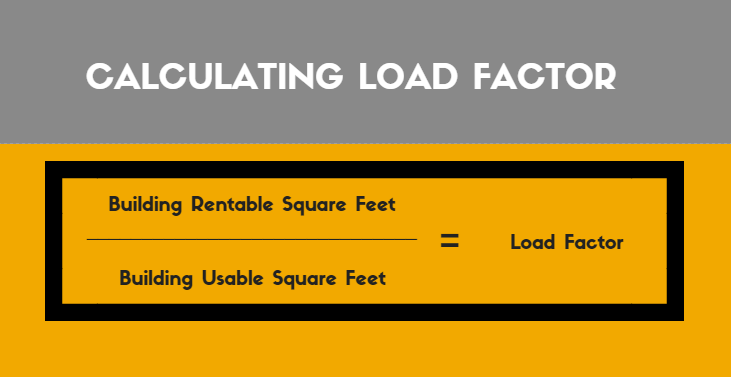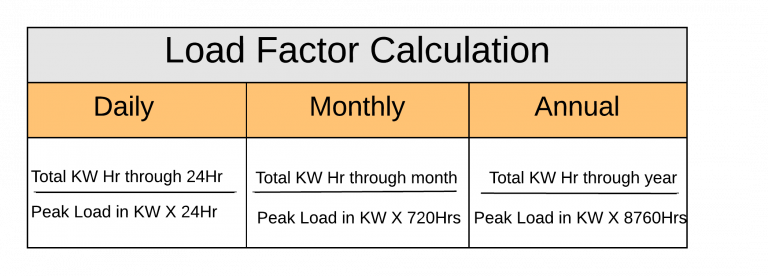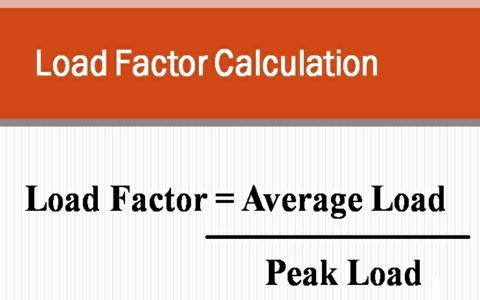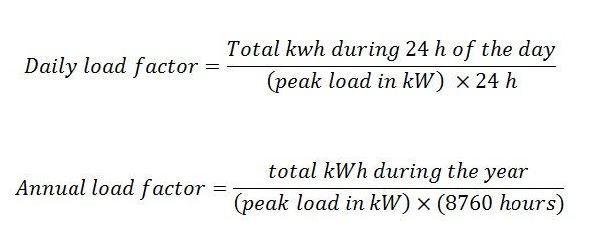The load factor is calculated as the amount of rentable square feet divided by the amount of usable square feet. For example, if an office building has 10,000 square feet of rentable space but only 8,000 square feet of usable office space, the load factor would be 1.25 (10,000/8,000).
How is load factor calculated?
The load factor calculation divides your average demand by your peak demand. To calculate your load factor take the total electricity (KWh) used in the billing period and divide it by the peak demand (KW), then divide by the number of days in the billing cycle, then divide by 24 hours in a day.
What is the load factor of a house?
In short, the load factor is the percentage of space on a floor or building that is not usable and is expressed using the simple formula of rentable area divided by useable area minus one.
How is the load factor defined?
A load factor is the ratio of the average electric load to the peak load over a period of time. The load factor is the actual kilowatt-hours delivered on a system in a given period of time, as opposed to the total possible kilowatt-hours that could be delivered in a given period of time.
What is the typical value of load factor?
Its value is always less than one because maximum demand is never lower than average demand, since facilities likely never operate at full capacity for the duration of an entire 24-hour day. A high load factor means power usage is relatively constant. Low load factor shows that occasionally a high demand is set.
What is the difference between load factor and add-on factor?
First off, Load Factor and Add-On Factor are the same thing. While loss factor tells you what percentage of the Rentable Area you can't use, Load Factor and Add-On Factor tell you how much larger the Rentable Area is than the Usable Area.





Value-add deals are safer than stabilized deals
— The Real Estate God (@TheRealEstateG6) October 31, 2023
There’s a common misconception that value-add deals (where you have to add value to the property and have execution risk) are automatically more dangerous than stabilized deals (where you buy the deal “finished” and don’t have to… pic.twitter.com/EhwswwKyIg
What is the load factor percentage in real estate?
In short, the load factor is the percentage of space on a floor or building that is not usable and is expressed using the simple formula of rentable area divided by useable area minus one.
Frequently Asked Questions
What is the formula for factor load?
To calculate your load factor take the total electricity (KWh) used in the month and divide it by the product of: peak demand (power)(KW), the number of days in the billing cycle, and 24 hours in a day. The result is a ratio between zero and one.
What is the average load factor of a building?
A medium load factor—40% to 60%—would be typical for offices, restaurants, schools, and other building types that have nighttime and weekend setbacks. There might be some variation through the year, depending on HVAC needs, but that is what you should expect to see for those types of structures.
What is rentable square feet load factor?
Load Factor
This number is based on the percentage of common area found in the building. Load factor is calculated by dividing the building's total rentable square feet by the total usable square feet. This load factor is then multiplied by the tenant's usable square feet to find the rentable square feet for the space.
What is the rule for load factor?
The load factor was how a project was tracked before project velocity became more popular. The load factor equals actual calendar days to complete a task divided by the developer's estimated "ideal" days to do it. That is, think of a task that would take you one day if you could focus completely on it.
What is a load factor in real estate?
A load factor, also known as a loss factor, is a metric that compares the amount of space a tenant has to pay for in a commercial lease, versus the amount of space they can actually use.
What does procuring cause refer to in real estate?
A procuring cause in real estate transactions refers to the real estate agent or broker whose actions resulted in the sale. As a result of their actions, that real estate professional is compensated with a commission from the property sale.
Which is the best definition of procuring cause?
"Procuring cause" may be defined as a series of events, unbroken in their continuity, that result in the desired objective (i.e., generally, the sale of property).
What is the key factor for proving procuring cause?
Preponderance of the evidence is a legal standard of proof that effectively means that the party claiming that they are the procuring cause must prove that it is more likely than not that they were responsible for procuring the buyer who bought a given property.
Is there a threshold for procuring cause?
Determining procuring cause requires a nuanced analysis of several factors and must be determined on a case-by-case basis. No one factor alone is determinative. Furthermore, there is no “threshold rule” that dictates that the agent who first showed the property is the procuring cause.
In which type of listing would the broker always need to prove procuring cause in order to collect a commission?
Open listings
Under open listings and exclusive-agency listings, an agent who was the procuring cause of the sale is entitled to a commission.
What is an example of a procuring cause?
Attending an open house without your real estate agent.
Attending an open house can cause a procuring cause dispute between your agent and the listing agent. The listing agent may claim that since they showed you the house, they were the procuring cause for you buying it instead of your agent.
What is the concept of procuring cause?
The National Association of REALTORS® defines procuring cause as the uninterrupted series of events that results in the successful transaction. There is no single action that makes an agent the procuring cause. For example, the first agent to show the property will not necessarily be determined the procuring cause.
What is the threshold rule misconception about procuring cause?
Determining procuring cause requires a nuanced analysis of several factors and must be determined on a case-by-case basis. No one factor alone is determinative. Furthermore, there is no “threshold rule” that dictates that the agent who first showed the property is the procuring cause.
What are 3 examples of procurement?
The three main types of procurement are direct goods or services, indirect goods or services, and professional services.
FAQ
- What is the formula for calculating load factor?
- The electricity demand (in kW) is your “peak load.” The load factor formula is: Monthly kWh/(monthly peak KW Demand * days in billing period * 24 hours). For example, imagine that you receive an electric bill that indicates 40,000 kilowatt hours of use, with a peak demand reading of 100 kilowatts.
- What is the load factor of commercial load?
- Detailed Solution
Mar 19, 2023Type of load Demand factor Load factor Domestic 70-100% 10-15% Commercial 90-100% 25-30% Industrial 70-80% 60-65% Agricultural 90-100% 15-25% - How do you calculate add on factor in commercial real estate?
- The add-on factor is the amount of usable square feet in a commercial property divided by the number of rentable square feet. The result of this calculation will be one if the two numbers are identical, but it is always lower than one because some square footage in a building will not be rentable.
- Is Mark Spain Real Estate legitimate?
- Is Mark Spain Real Estate Legit? Yes, Mark Spain Real Estate is a legitimate company founded by Mark Spain in 2016. Their experienced agents have closed over $3.3 billion in transactions and served over 10,300 clients.
- Is Mark Spain part of Keller Williams?
- In 2011, after 15 years of practicing real estate, Mark Spain joined Keller Williams and formed the Mark Spain Team.
- How much do Mark Spain listing agents make?
- The estimated base pay is $65,698 per year. The estimated additional pay is $36,822 per year. Additional pay could include bonus, stock, commission, profit sharing or tips. The "Most Likely Range" represents values that exist within the 25th and 75th percentile of all pay data available for this role.
- Is Mark Spain a brokerage?
- Mark Spain Real Estate has served in the real estate industry for nearly 30 years with over 50,000 satisfied clients. We are a full-service brokerage with the best-personalized options to suit your needs. Contact us today!
- What is a Mark Spain guaranteed offer?
- If you need to sell quickly, it may be worthwhile to get a Mark Spain Guaranteed Offer. The company makes cash offers in about 48 hours and can close in 3 weeks. Your home needs to meet the following purchase criteria to get an offer: Single-family home built after 1960. Worth $50,000–650,000.
- Does Mark Spain Real Estate charge commission?
- Mark Spain Real Estate will sell your home for a 4% commission, rather than the normal 6% commission.
- Is Mark Spain Realtor married?
- Mark is the CEO of Mark Spain Real Estate and is married with 4 daughters and 1 son. What advice do you have for dads to constantly grow and improve while being a great dad, too?
- What are the pros and cons of Mark Spain Realty?
- Pros: Mark Spain Real Estate offers a three-week closing promise. Their experienced agents have closed over $3.3 billion in transactions and served over 10,300 clients. Cons: It prefers properties without structural damage, foundation issues, or unpermitted additions.
- Did Mark Spain work for Keller Williams?
- In 2011, after 15 years of practicing real estate, Mark Spain joined Keller Williams and formed the Mark Spain Team. Over the next 5 years, the Mark Spain Team helped over 3,500 families close on their homes. In 2016, Mark Spain announced independence from Keller Williams and formed Mark Spain Real Estate.
- What are the pitfalls of buying property in Spain?
- What are the pitfalls of buying property in Spain?
- Not having your documents prepared in advance.
- Incomplete property research.
- Avoiding professional help, such as real estate agencies or solicitor services.
- Not understanding the real costs when buying a property.
- Not understanding the contracts and full process.
- Who is the procuring cause of a real estate transaction quizlet?
- The broker that produces the buyer is the one who has earned a commission under an open listing; the broker is referred to as the "procuring cause."
What is a load factor in real estate
| What defines procuring cause in a real estate transaction? | In real estate, procuring cause refers to the series of events initiated by the real estate agent who ultimately helped the buyer close on the home. If the buyer used more than one agent, determining procuring cause – and ultimately which real estate agent gets the commission on the sale – can be difficult. |
| How is procuring cause determined? | What is Procuring Cause? The National Association of REALTORS® defines procuring cause as the uninterrupted series of events that results in the successful transaction. There is no single action that makes an agent the procuring cause. |
| What type of listing entitles a commission only to the broker who was the procuring cause? | Open listing contract An open listing contract is a type of non-exclusive listing contract in which the seller works with multiple brokers to list the property and only pays a commission to the broker that secures the buyer that ultimately purchases the property. |
| What is a procuring cause agent quizlet? | Procuring cause. The real estate agent who is primarily responsible for bringing about a sale; the one who actually negotiates an agreement with the ready, willing, and able buyer. |
| Does Mark Spain sell houses? | Mark Spain Real Estate is a brokerage that offers home selling, buying, and renting services. The company can also buy homes for cash through its Guaranteed Offer program. Mark Spain started the firm in Georgia, and it now has offices and realtors throughout the Southeastern US. |
| How much does Mark Spain spend on advertising? | Estimating that the team collectively spends well over $1 million a year in its marketing efforts, Spain said, “We don't make the mistake of ever thinking we are done with marketing or getting our team's name in front of the public. It's an ongoing process that we adjust to incorporate the latest technology.” |
| How does mark spain real estate work | Mark Spain Real Estate sells over 57 homes per day on average. Get a Guaranteed Offer and work with the most trusted and #1 team in real estate so you can close |
| What is the commission rate for Mark Spain? | A 4% commission A. The main reason most homeowners use the Builder Referral Program is to save money on real estate commissions. Mark Spain Real Estate will sell your home for a 4% commission, rather than the normal 6% commission. This is a savings of thousands of dollars to you. |
| What is real estate commission in Spain? | The commission In Spain, real estate commissions are not regulated, this means the market regulates itself on supply and demand. As a rule of thumb, real estate agencies will charge anything in between 3% and 6% of the final sale price. To this amount you'll need to add VAT (value added tax of 21%). |
| What is the Georgia Real Estate Commission? | GREC is the regulatory body responsible for regulating the brokerage industry and licensing real estate practitioners. You'll want to learn about GREC because they have the greatest influence on how you can get and keep your Georgia real estate license. |
| Is Mark Spain a good real estate company? | Mark Spain Real Estate is a reputable real estate brokerage with a strong presence in major Southeast U.S. and Texas metro areas. Their Guaranteed Offer program offers homeowners a cash offer in just 48 hours, allowing for a fast and convenient home sale. |
| What is a typical load factor office building? | The difference between the usable square footage and rentable square footage is called the load factor. Load factors can vary between 12% and 25%; high-rise office buildings typically have a higher load factor. How do you calculate load factor? |
| How do you calculate load factor in commercial real estate? | The load factor is calculated as the amount of rentable square feet divided by the amount of usable square feet. For example, if an office building has 10,000 square feet of rentable space but only 8,000 square feet of usable office space, the load factor would be 1.25 (10,000/8,000). |
| What is the load factor in commercial real estate? | The load factor is calculated as the amount of rentable square feet divided by the amount of usable square feet. For example, if an office building has 10,000 square feet of rentable space but only 8,000 square feet of usable office space, the load factor would be 1.25 (10,000/8,000). |
- What is Boma load factor?
- This ratio, or load factor, is determined by dividing the total rentable area by the total usable area. This will usually result in a figure of about 1.10 to 1.15.
- What is a load factor in office real estate?
- A load factor, also known as a loss factor, is a metric that compares the amount of space a tenant pays for in a commercial lease versus the amount of space they actually use.
- How do you calculate the load factor?
- To calculate your load factor take the total electricity (KWh) used in the billing period and divide it by the peak demand (KW), then divide by the number of days in the billing cycle, then divide by 24 hours in a day. The result is a ratio between zero and one.
- How do you calculate office building load?
- Calculating Load
- Add together the wattage capacity of all general lighting branch circuits.
- Add in the wattage rating of all plug-in outlet circuits.
- Add in the wattage rating of all permanent appliances (ranges, dryers, water heaters, etc.)
- Subtract 10,000.
- Multiply this number by .
- Add 10,000.
- Calculating Load
- What is the load factor per floor?
- To find the load factor, you divide the usable square footage into the rentable square footage and subtract one. So, in this example, you would divide 13,100 into 15,500 to get 1.183. Then, if you subtract one from that quotient, you get 0.183, or 18.3 percent. This means that the floor has an 18.3 percent load factor.
- Who is mark spain real estate
- May 11, 2022 — Mark Spain Real Estate was founded in 2016 by Mark Spain, founder and chairman of the brokerage. After graduating from the Terry College of
- Is it a good time to buy property in Spain now?
- Is it a good time to buy property in Spain 2023? Yes, for sure, as you can see, prices are rising since 2014 but are far from the top of 2008. Returns are healthy and not excessive while financing remain low. Read more in our paper.
- Why are realtor reviews important?
- Positive reviews from your previous clients provides invaluable social proof that establishes your skills, professionalism, and most importantly, helps you stand out from the competition.
- What is a load factor real estate?
- A load factor, also known as a loss factor, is a metric that compares the amount of space a tenant pays for in a commercial lease versus the amount of space they actually use.
- How is house load calculated?
- Calculating Load After you know the capacity of individual circuits and of the home's full electrical service, you can then compare this with the load, which you can calculate simply by adding up the wattage ratings of all the various fixtures and appliances that will be drawing power at the same time.
- What is a procuring cause in real estate
- May 15, 2023 — A real estate agent is referred to as the procuring cause of a home purchase if they are the one who caused the buyer to purchase a home.
- What is the procuring cause of the transaction?
- Procuring cause is the determining act or effort that successfully acquires a customer or transaction. It's the pivotal action or factor that initiates, facilitates, or brings about a specific desired outcome in a given context.
- What best describes the concept of procuring cause?
- What Is Procuring Cause? A procuring cause in terms of real estate transactions is known to be the real estate agent or broker that his or her actions brought about the sale of the property.